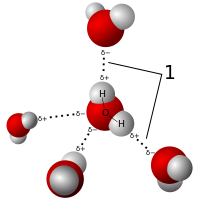
Photo from wikipedia
Complexation with a metal ion of an organic molecule containing one or more intramolecular hydrogen bonds (IHBs) influences the characteristics of the IHBs. These influences are here investigated computationally for… Click to show full abstract
Complexation with a metal ion of an organic molecule containing one or more intramolecular hydrogen bonds (IHBs) influences the characteristics of the IHBs. These influences are here investigated computationally for the complexes of selected antioxidant acylphloroglucinols with a Cu2+ ion, and also the complexes of a number of structurally-related molecules meant to highlight the influence of specific molecular features. All the low energy conformers of acylphloroglucinols (compounds structurally derived from 1,3,5-trihydroxybenzene and characterised by the presence of a CRO group) contain an IHB between the sp2 O of CRO and a neighbouring phenol OH. Additional O–H···O or O–H···π IHB are present when the molecule contains substituents with groups that can form IHBs. The results show various effects that can be ascribed to complexation, such as changes in the IHB parameters and in the red shift of the vibrational frequency of the donor OH caused by the IHB. For O–H···O IHBs, complexation may cause the transfer of the proton from the donor to the acceptor O atom, more frequently when the acceptor is an sp2 O (i.e. for stronger IHBs). In some cases, IHBs that are not present in the uncomplexed conformers appear in the complex. The type and extent of the changes depend mainly on the site/s to which the Cu2+ ion binds and, to a less extent, also on the geometry features of the conformer. Some changes offer clear indications of weakening or strengthening of specific IHBs for specific binding sites of the ion.
Journal Title: Theoretical Chemistry Accounts
Year Published: 2019
Link to full text (if available)
Share on Social Media: Sign Up to like & get
recommendations!